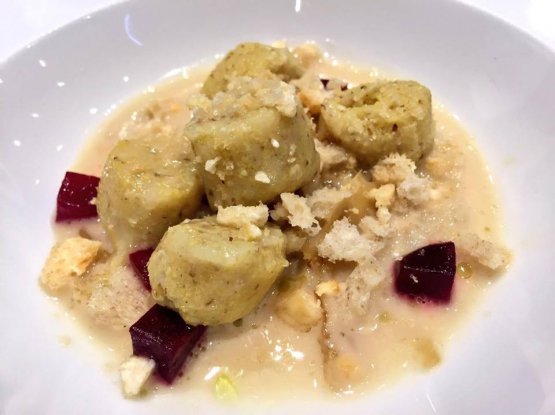Italian-Chicagoan Vince Gerasole, a perfectly timed journalist, opened the third edition Identità Chicago at Eataly’s Scuola, at the Loop. After explaining the general mission of Identità Golose, to the audience, Vince passes the microphone to Paolo Marchi: «We’re happy because in our trips overseas, this is the first time we start in Chicago and not New York, the first city that comes to our mind in Europe. Everyone knows Italian food, but often, what with overcooked pasta and stereotypes, it’s a fake cuisine. This year’s theme is Don’t waste the planet because we don’t have enough resources on our planet and it’s time we all realise it».
After the sparkling introduction offered by Cristina Ziliani of Berlucchi («You call it Berlucci, no worries»), it’s time for Giancarlo Perbellini of Casa Perbellini, a restaurant he opened late in 2014 right in the heart of Verona, 2 Michelin stars in one blow: «At our restaurant», the chef from Verona says calmly introducing his lesson, «every single table is basically a chef’s table, that is to say it’s inside the kitchen. And every guest can see what we’re preparing. Do we chefs speak? Only the sous chef can».

Gnocchi made with polenta from Storo, bread, cabbage, beetroot and broth with goat cheese and powdered Grana Padano crust by Giancarlo Perbellini, the dish opening the third edition of Identità Chicago
 Perbellini
Perbellini’s words are very pondered even here. Yet effective: «Our cuisine is product-focused, we interpret the season and change menu every 40 days». The format is original: «Clients choose the ingredients and we chefs decide what to do». The dish presented in Chicago is based on
Gnocchi, the emblem of Verona. They’re made with polenta from Storo, «it’s a special red polenta they only make in this village near Trento. It’s a recipe with leftovers, which was once extremely popular in our countryside».
With this recipe you recuperate polenta, stale bread and the crust of
Grana Padano, which is cooked in chicken stock a «Sunday tradition» and very concentrated («5 litres from the initial 20») and then put in the microwave oven. Next to it, seasonal vegetables: crispy cabbage and pan-toasted beetroot. A tasting with a minimal food cost, yet very effective in its elegance. With a noble meaning: «Our role is to show that, by moving back to the past and using only seasonal ingredients, we can create benefits and protect the Earth». Want to taste it? Go to Piazza San Zeno: «It’s in the menu as of October».
Lesson one, part two. It’s now the turn of
Sarah Grueneberg, the volcanic chef at
Monteverde in Chicago, “restaurant & pastificio”, a place seating 300 people in the evening, opened 10 months ago. It’s so special and interesting we’ll soon pay another visit. «I come from Texas, so I don’t need a microphone», the chef, for many years beside
Tony Mantuano, her mentor at
Spiaggia, begins full of liveliness.

Spaghetti Monograno Felicetti, Grana Padano, Pecorino Romano and Toscano, ricotta with whey, a blend of 4 types of pepper by Sarah Grueneberg, a rising star in Chicago’s restaurant scene, now for 10 months at the helm of Monteverde, "restaurant & pastificio"

The dish is called
Cacio whey pepe and the key element is indeed the whey. She says: «This recipe was born by mistake: I was making
Cacio e pepe for my boyfriend. We had just visited a farm, looking for high quality eggs – essential for the tons of fresh pasta we prepare every night. At one point they gave me a gallon of raw milk, which is illegal but very exciting for a chef. Starting from an intuition, I decided to use the whey for the final emulsion with the cooking water from the pasta – you usually discard the whey, and that indeed is legal – instead of the butter». This trick made her win the dish of the year award from the very popular
Bon Appetit magazine (which joins many other important prizes).
In between there’s a laborious preparation, «made with simplicity, yet not simple»
Paolo Marchi effectively sums up at the end of the lesson. They use
Spaghettoni with Matt
Monograno Felicetti, removed from the water 5 minutes before what’s suggested on the pack. You toss them energetically in the pan for 5 more minutes with chunks of ricotta crumbled on top with your hands, previously cooked on a low heat with a little salt and whey.
To the side, in a mortar, she grated with a Microplane three types of cheese:
Grana Padano, Pecorino Romano and a second Pecorino, less salty. «It usually comes from Tuscany or Sardinia», the chef explained. She finishes with a blend of four types of black pepper. A dish rich of flavour and lightness, with a beautiful acidity and an important characteristic, which
Sarah pointed out: «Every piece of spaghettone has its sauce». Which, come to think about it, almost never happens with the classic recipe.